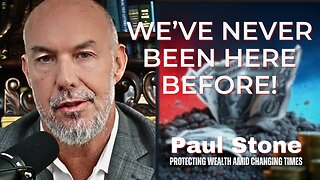Premium Only Content

American Monthly Mortgage Payment Explodes to $3,322 In Biden's America , Amerifornia is Real
Just Like we been saying for years ! Wagons East as Amerifornia is real
#mikeinthenight #mikemartins
Supply and Demand Imbalance: One of the fundamental factors is the imbalance between the demand for housing and the available supply. If the demand for homes outpaces the number of homes available for sale, prices tend to rise.
Population Growth: Areas experiencing significant population growth often face increased demand for housing. This is particularly true in regions with strong job markets and economic opportunities, attracting people to relocate.
Low Housing Inventory: Limited housing inventory, resulting from factors like restrictive zoning laws, slow construction, or limited available land for development, can contribute to a scarcity of housing, driving up prices.
Low Interest Rates: When interest rates are low, mortgage financing becomes more affordable. This can lead to an increase in demand for homes as more people can qualify for loans, putting upward pressure on prices.
Economic Expansion: During periods of economic growth, individuals and families may feel more confident about their financial prospects, leading to increased demand for homeownership. This heightened demand can contribute to rising housing prices.
Investor Activity: Real estate investors, including institutional investors and individuals, can impact the market dynamics. Large-scale investments in residential properties for rental purposes or speculation can contribute to increased demand and rising prices.
Cost of Construction: If the cost of construction materials and labor increases, it can drive up the cost of building new homes. This, in turn, can impact the pricing of existing homes, as the cost of new construction sets a benchmark for the market.
Urbanization and Gentrification: Urbanization trends and the revitalization of urban areas often lead to increased demand for housing in city centers, contributing to gentrification and higher property values.
Government Policies: Policies related to housing, such as tax incentives, zoning regulations, and development incentives, can influence the housing market dynamics and contribute to price increases.
Pandemic-Related Impacts: The COVID-19 pandemic has influenced housing market trends, with changes in remote work patterns leading to increased demand for housing in suburban and rural areas, further intensifying competition and price appreciation.
It's important to note that these factors can interact and amplify one another, creating a complex and interconnected web of influences on housing prices. Market conditions can vary significantly by location and over time, and local factors can play a crucial role in understanding the specific dynamics of a particular housing market.
housing prices, real estate market, supply and demand, population growth, housing inventory, interest rates, economic expansion, investor activity, cost of construction, urbanization, gentrification, government policies, pandemic impact, remote work trends, suburban housing, rural housing, housing affordability, mortgage rates, job markets, economic opportunities, zoning regulations, construction materials, housing demand, market dynamics, property values, tax incentives, housing development, housing scarcity, real estate investment, homebuying trends, housing competition, housing market trends
-
 1:36
1:36
Mike Martins Channel
7 days ago $0.03 earnedALL I WANT FOR CHRISTMAS
3113 -
 DVR
DVR
Jesús Enrique Rosas
2 hours agoEp. 51: Gates wants CENSORSHIP, Colbert MESSES UP, AOC meltdown, Hanks LEAVING and MOAR!
7.89K1 -
 1:45:47
1:45:47
The Quartering
4 hours agoHuge Censorship Law To Pass, Trump Endorses Johnson, TikTok is Saved? & Today's News!
55.1K27 -
 1:31:21
1:31:21
Tucker Carlson
3 hours agoBrigham Buhler: UnitedHealthcare CEO Assassination, & the Mass Monetization of Chronic Illness
136K109 -
 2:29:04
2:29:04
Nerdrotic
4 hours ago $9.15 earnedHappy New Years - Nerdrotic Nooner 454
54.4K3 -
 32:20
32:20
Rethinking the Dollar
3 hours agoThe U.S. Debt Crisis That Was "Made In America" w/ Paul Stone
33.4K6 -
 3:31
3:31
SLS - Street League Skateboarding
1 day agoCoco Yoshizawa’s 3rd Place Finish at SLS Tokyo 2024 | Best Tricks
34.9K3 -
 46:15
46:15
Grant Stinchfield
23 hours ago $9.98 earnedNew: The COVID Cover-up Revealed! Team Biden Caught in a Big Lie!
36.1K9 -
 2:35:08
2:35:08
The Shannon Joy Show
18 hours ago🔥🔥LIVE Exclusive W/Daniel Horowitz - New Year 2025 Analysis On Culture, Economy & Politics🔥🔥
45.8K7 -
 33:14
33:14
Tudor Dixon
3 hours agoThe World Walk with Tom Turcich | The Tudor Dixon Podcast
30.4K